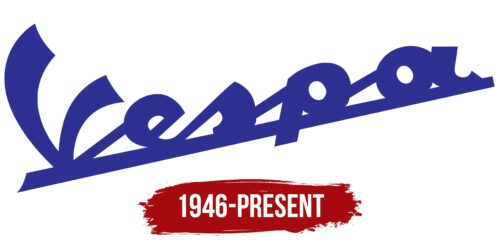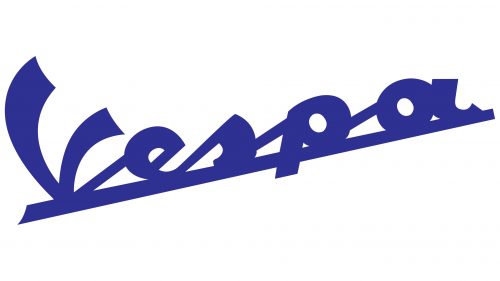The Vespa logo reflects determination, positivity, and originality, representing the brand of Europe’s most famous scooter. The emblem embodies freedom of movement and a wide customer reach, showing how effortlessly one can feel when using this manufacturer’s vehicles.
Vespa: Brand overview
The history of Vespa began on April 23, 1946, when the Italian company Piaggio & C. S.p.A. registered a patent for a “motorcycle with a rationally designed complex of parts and elements, combined with a frame with shields forming a supporting structure.” This day is considered Vespa’s official birthday.
The idea for the brand was born in post-war Italy. Enrico Piaggio, the owner of Piaggio, which had produced aircraft before the war, sought a way to repurpose production for peacetime needs. He tasked engineer Corradino D’Ascanio with developing an affordable and practical means of transportation for the masses.
Inspired by American scooters he had seen during the war, D’Ascanio created a prototype with a unique design. When Enrico Piaggio saw the prototype, he exclaimed, “Sembra una vespa!” (It looks like a wasp!) due to the engine’s distinctive sound and body shape. Thus, the name Vespa was born.
The first model, Vespa 98, was presented to the public in 1946 at a golf course in Rome. It immediately attracted attention with its innovative design: the body completely covered the engine and transmission, protecting the rider’s clothing from dirt and oil. Additionally, the front fork allowed for easy wheel changes in case of a puncture.
In the first year, only 2,484 scooters were sold, but by 1950, production had reached 60,000 units per year. The brand quickly became a symbol of Italian style and mobility.
The 1950s were the golden age for the manufacturer. In 1953, the film “Roman Holiday,” starring Audrey Hepburn and Gregory Peck, featured the main characters riding a scooter around Rome. This significantly boosted the scooter’s popularity worldwide.
The millionth scooter was produced in 1955. By the decade’s end, they were being produced under license in Germany, the UK, France, Belgium, Spain, and India.
The 1960s brought new models and technological innovations. 1968 the revolutionary Vespa Primavera was introduced, becoming one of the most popular models ever.
The 1970s saw the release of more powerful models. In 1976, the PX model with a 200cc engine was introduced, becoming a bestseller for many years.
In the 1980s, the company faced growing competition from Japanese manufacturers. However, it managed to maintain its position thanks to its unique design and adherence to tradition.
The 1990s saw a resurgence of interest in retro style. The ET4 model, introduced in 1996, combined classic design with modern technology, including a four-stroke engine.
In the 2000s, the brand continued to evolve, introducing a range of new models. 2003, the GranTurismo model was launched, featuring a more powerful engine and improved suspension.
2006 marked the company’s 60th anniversary. To celebrate, a special 60° series was released.
In 2008, the manufacturer introduced its first hybrid model, the LX HyS, demonstrating its commitment to eco-friendly technology.
The 2010s were notable for the release of several iconic models. In 2013, the 946 model, a luxury model inspired by the original 1946 prototype, was introduced.
In 2018, the company took a significant step into the future by presenting its first fully electric model, the Elettrica.
2021 marked the brand’s 75th anniversary. A special 75th series was released to commemorate this milestone, available in the Primavera and GTS models.
Throughout its history, the manufacturer has remained more than just a means of transportation; it has become a cultural phenomenon. It has inspired artists, designers, and filmmakers, symbolizing freedom and the Italian lifestyle.
Meaning and History
What is Vespa?
This Italian scooter manufacturer is famous for producing fashionable, useful, and easy-to-ride two-wheelers. The company was founded by Piaggio & Co. in Pontedera, Italy, and has since become a symbol of Italian design, culture, and urban mobility. The distinctive steel unibody design of this brand’s scooters ensures stability and protection for the rider. The company offers many models to suit every taste, from retro-style classics to ultra-modern models with the latest technologies. The brand has a loyal following and is a popular option for commuters and enthusiasts worldwide.
1946 – today
The Vespa logo consists of a single element—the name—which was styled originally. Designers transformed the ordinary text into an unconventional graphic element that effectively advertises the product. It embodies dynamism, which is essential for two-wheeled and four-wheeled vehicles.
The text is set in an italic font with extra-bold lowercase letters. The stroke widths vary; they are narrower where the letters connect. This design choice improves glyph identification and readability. Without these thickness transitions, the letters would blend together and be hard to distinguish. Designers solved this issue by narrowing the connection points between symbols. Small diagonal lines are used in places without natural transitions to maintain the text’s cohesiveness.
This design makes the emblem colorful, striking, and harmonious. A long, lower stroke running beneath the entire word “Vespa” adds visual balance. In Italian, “Vespa” means “wasp,” which aligns perfectly with the scooter brand’s concept, as this insect flies forward quickly, cutting through the air with a loud buzz. Although the logo doesn’t feature an actual wasp, the diagonal placement of the text suggests it is zooming upward at full speed, outpacing other traffic.
The Vespa logo serves a marketing purpose by showing customers how quickly the two-wheeled vehicle can cover distances, its technical perfection, and its maneuverability. The mark effectively represents the characteristics and capabilities of the brand’s scooters.
The letters have a unique appearance. For example, the “s” lacks an upper loop, the “V” curves like a scooter handlebar, and the “e” is set diagonally. This design reflects the lively nature of a swift insect and conveys the agility of a scooter that can navigate even the most challenging corners.
The blue color symbolizes forward movement, determination, the pursuit of new heights (in this case, technology), freedom, and high speed. It also represents stability, reliability, and calmness. This color positively affects people, balancing emotions and instilling confidence.





